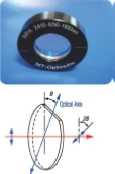Mounted Waveplate
For pricing, technical or any other questions please contact the supplier
- No registration required
- No markups, no fees
- Direct contact with supplier
-
Ships from:
China
-
Sold by:
MT-Optics, Inc. -
On FindLight:
since 2025
Description
A wave plate, also known as a phase retarder, is an optical device made from birefringent materials like quartz or mica. It manipulates the polarization state of light by introducing a precise phase difference between the two orthogonal polarization components as light passes through. Depending on the desired phase retardation, wave plates are classified into quarter-wave plates, half-wave plates, and zero-order wave plates, each designed to control the polarization rotation and phase shift of light beams accurately.
Mounted Waveplate
Specifications |
|
|---|---|
| Waveplate Type: | Zero Order, Multiple Order, Achromatic |
| Material: | Quartz |
| Mounting: | Mounted |
| Shape: | Round |
| Retardation: | Not Specified |
| Retardation Accuracy: | +/- Lambda/300 |
| Wavefront Distortion: | <= Lambda/8 |
| Surface Quality (Scratch-Dig): | 20-10 |
| Thickness: | 0.2-0.5 mm |
| Material: | Quartz |
| Diameter Tolerance: | +0.0, -0.1mm |
| Wavefront Distortion: | N8@ 632.8nm |
| Parallelism: | <1 arc second |
| Surface Quality: | 20/10 |
| Clear Aperture: | >90% |
| Coating S1&S2: | R<0.2%@ wavelength |
| Standard Wavelength: | 266nm, 355nm, 400nm, 532nm, 632.8nm, 780nm, 808nm, 850nm, 980nm, 1064nm, 1310nm, 1480nm, 1550nm |
| Retardation Tolerance: | N100 |
| Coating: | R<0.2%@ foundational wavelength & R<0.5%@ SHG wavelength |
Features
Wave plates play a crucial role in numerous optical systems. In laser processing, they assist in optimizing laser beam polarization for improved cutting, welding, and material ablation efficiency. In optical microscopy, wave plates enhance imaging contrast by precisely adjusting light polarization, enabling detailed observation of birefringent samples. They are also essential in optical communication systems, where they help modulate and control the polarization of optical signals, reducing signal loss and interference. Additionally, wave plates find extensive use in scientific research, such as in spectroscopy and interferometry, for polarization analysis and phase manipulation.
Applications
- Half Waveplate: Rotates linearly polarized light to any desired orientation. The rotation angle is twice the angle between the incident polarized light and the optical axis.
- Quarter Waveplate: When linearly polarized light is input at 45 degrees to the axis of a quarter waveplate, the output is circularly polarized. Similarly, input circularly polarized light is transformed into linearly polarized light.
- Low Order Waveplate (Multi-Order): The retardance of a light path will undergo a certain number of full wavelength shifts in addition to the fractional design retardance. The thickness is usually around 0.5mm. Compared with zero order waveplate, multi order waveplate is more sensitive to wavelength and temperature changes but are less expensive and widely used in many applications where the increased sensitivities are not critical.
- Dual Wavelengths Waveplate: A multiple waveplate that provides a specific retardance at two different wavelengths.
Frequently Asked Questions
A waveplate is an optical device made from material exhibiting birefringence, where the polished faces contain the optical axis. It causes a phase difference between extraordinary and ordinary rays due to different velocities through the material.
A half waveplate rotates linearly polarized light to any desired orientation. The rotation angle is twice the angle between the incident polarized light and the optical axis.
A quarter waveplate transforms linearly polarized light into circularly polarized light when input at 45 degrees to the axis, and vice versa for circularly polarized light.
Low order waveplates have a high damage threshold, better temperature bandwidth, and are low cost. They are less sensitive to wavelength and temperature changes compared to zero order waveplates.
The waveplates are made from quartz.
A dual wavelength waveplate is a multiple waveplate that provides specific retardance at two different wavelengths.
The standard wavelengths available are 266nm, 355nm, 400nm, 532nm, 632.8nm, 780nm, 808nm, 850nm, 980nm, 1064nm, 1310nm, 1480nm, and 1550nm.

